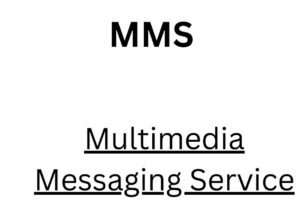MMS stands for “Multimedia Messaging Service.” It is a technology that allows users to send and receive multimedia content, such as pictures, videos, audio clips, and text messages, from one mobile device to another.
MMS extends the capabilities of traditional SMS (Short Message Service) by enabling the transmission of various media files, making it a more versatile and engaging way to communicate. Users can share moments, experiences, and information in a more visual and interactive manner through MMS messages.
What Is MMS Full Form?



MMS stands for Multimedia Messaging Service. It is a standard way to send and receive text messages, images, and videos over a cellular network. MMS was first introduced in the early 2000s and has since become a popular way to communicate with friends and family. MMS messages can be sent to any mobile phone that supports MMS. To send an MMS message, you need to have a cellular data plan that includes MMS messaging. You can also send MMS messages from a computer using a web-based MMS service.
MMS messages can be up to 300 KB in size, which allows you to send larger files than you can with a text message. You can also send multiple images and videos in a single MMS message. MMS messages are sent over the cellular network, so they can be expensive. However, many cellular carriers offer unlimited MMS messaging as part of their plans.
History Of MMS
MMS, or Multimedia Messaging Service, was first introduced in 1999 by the WAP Forum, a group of mobile phone manufacturers and operators. MMS was designed to allow mobile phone users to send and receive text messages, images, and videos over a cellular network. The first commercial MMS service was launched in Finland in 2000. MMS quickly gained popularity in Europe and Asia, and it was introduced to the United States in 2002.
MMS has been steadily growing in popularity over the years. In 2019, there were an estimated 1.3 trillion MMS messages sent worldwide. MMS is supported by most mobile phones. However, not all mobile phones support all features of MMS, such as sending and receiving videos. MMS messages are sent over the cellular network, so they can be expensive. However, many cellular carriers offer unlimited MMS messaging as part of their plans.
Benefits Of Using MMS
Here are some of the benefits of using MMS:
- You can send larger files than you can with a text message.
- You can send multiple images and videos in a single message.
- MMS messages are supported by most mobile phones.
Drawbacks Of Using MMS
Here are some of the drawbacks of using MMS:
- MMS messages can be expensive.
- MMS messages can be slow to send and receive.
- Not all mobile phones support MMS messaging.
Frequently Asked Question
MMS stands for Multimedia Messaging Service. It is a standard way to send and receive text messages, images, and videos over a cellular network.
- You can send larger files than you can with a text message.
- You can send multiple images and videos in a single message.
- MMS messages are supported by most mobile phones.
- MMS messages can be expensive.
- MMS messages can be slow to send and receive.
- Not all mobile phones support MMS messaging.
No, MMS is not the same as SMS. SMS stands for Short Message Service. SMS messages are limited to 160 characters, while MMS messages can be up to 300 KB in size. MMS messages can also contain images and videos.
Conclusion
Finally, MMS, which stands for “Multimedia Messaging Service,” has greatly improved the way we communicate via mobile devices. MMS has revolutionised mobile messaging by allowing users to send and receive multimedia information such as photographs, videos, audio clips, and text messages. This allows for a more engaging and interactive communication experience.
This technology has enabled users to visually communicate moments, feelings, and information, allowing for a higher sense of connection with others. MMS has become an essential part of our daily lives, helping us to capture and share memories, express ourselves creatively, and stay more meaningfully connected with loved ones. As technology advances, MMS is expected to remain a dominant and vital mode of communication, enriching lives.






